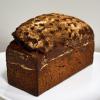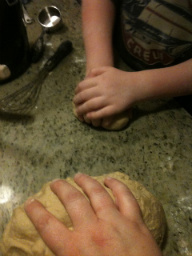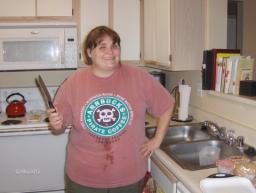There is something almost primal about home-baked bread.
For millennia, mostly women (but I'm sure some men too) across every single continent have engaged in a fairly painstaking process of patiently grinding wheat or corn into flour, finding and adding just the right amount of water, and kneading, kneading, kneading until, finally, on a flat rock in the sun or atop an enclosed fire somewhere the cornerstone of the human diet was finished. How could they have known how much water to add, or that one must knead and not beat or grind the dough? Perhaps bread was born within us and simply came out.
Maybe it emerged in the form of a baguette, or a tortilla, a loaf, a pita, a crust or a stick, but it was bread and it was being made every day by somebody somewhere.
Humans engaged in this long process, over and over again, for their children, their mates, their communities or themselves. To celebrate, to mourn, to barter or to heal. In honor of their religion and sometimes, even, bread was made to renounce religion. Bread was at once precious and yet universal. It was for the rich to enjoy, the poor to need and the destitute to yearn for.
Environment, time and later wealth would play their defining roles, of course.
In France the nobles feasted on croissants, a rich bread because it required eggs for browning and a scandalous amount of butter.
Meanwhile, in Tuscany, the bread had to last and was often stale. Not to be denied any pleasure, the Tuscans soaked the leftover slices of the long, narrow loaves in olive oil and topped with basil and tomatoes and re-warmed the bread over the fire. Today, you can pay up to $25.00 for a plate of that--only we call it bruschetta and the bread isn't usually stale (though it may have been deliberately left out overnight to harden for authenticity).
French toast, or as I grew up calling it, arme ritter (poor knight) was fed as a dessert dish to knights. It contained key ingredients wealthier noblemen were likely to have, such as milk and eggs. As such, it was considered a bit of a luxurious dish and by serving it the noblemen were paying the knights proper respect...that being said, it was also appealing because it was a dish that was still relatively cheap to provide. In fact, French toast is sometimes called "The Poor Knights of Windsor."
Rich, poor, warring or at peace....everyone ate or at least needed bread. Of all the foods in the world, it is bread that became synonymous with currency the world over (lettuce is a distinctly American term).
All of which is well and good, of course, and lends to a deep sense of comfort when baking bread, but doesn't have a whole lot to do with why I bake it.
No, I think it would be far more accurate to say that I love dough more than I love baking bread.
I love the dough.
I love the way yeast proofs in warm water, as though the water, at just the right temperature, was holding some eternal secret of life and by adding the yeast and waiting I discovered it. Dough is love, and love is the essence of life.
I love how it transforms from a sticky, gooey sludge into a smooth, warm and elastic dough with just a bit of patient coaxing from my fingers. That my small, weak and unskilled hands could produce such an strong but elastic substance amazes me just a little bit each and every time.
I especially associate yeast dough with love. Like love, yeast dough is pliable but strong, but also requires just the right amount of attention to become something life-sustaining. Given too much kneading or water or flour, it can be ruined in an instant and become stiff, dry or cracked. Sometimes, just sometimes, like particularly strong love, if the dough has become too watery and is getting away from the baker, it can be fixed by slowly and carefully adding flour.
Both yeast dough and love can be coaxed, cajoled, rolled, folded and rocked into shape, but never, ever forced.
You have to truly feel the dough to understand it, and if you are only going through the motions you may end up with bread that is edible, but not bread that is also joyous. Yeast dough, like love, will give back whatever you put into it, and if you don't pay attention you will end up with nothing but a useless, heavy mass and a lot of wasted time you can never get back.
Yeast dough is warm from the inside out and, without even touching it, yeast dough can grow and grow until it doubles or triples in volume and can seem unstoppable. Anyone who has ever secretely loved another can surely relate.
The warmth of yeast dough doesn't come from an oven or a grill, but emanates gently from within it. Cover the bowl, come back in an hour or even just twenty minutes and--magic!--twice as much dough as there was before.
And like love, even punching it down a bit and reshaping it won't stop the way it will grow from within.
Some breads, just like some loves, need a bit more attention even when they're in the oven.
A baguette, for example, has to be perfectly misted while baking.
A challah bread (and is there any bread that celebrates life, family, love and tradition more? And no, I'm not Jewish, but it really is one of the richest breads in so many ways) won't settle for being shaped but must be braided.
The quietly demanding sourdough requires no less than at least three days of your time for the starter and, even then, can be a bit fickle.
And the croissant is a downright diva, demanding days of preparation and folding process akin the welding and hammering that goes into a genuine Samurai sword (only slightly less than 100 layers). It is a deceptively innocent-looking bread that requires a remarkable amount of skill.
Yes, some breads require the attention of a lover, others are as demanding as children, still other are as low-maintenance and accepting as an old friend, and still other breads ultimately require the patience, work and understanding that love for family and in-laws are exceedingly likely to require.
But all of them, if done properly, are unquestionably worth every second.
Naturally, after taking a golden-brown or spice-speckled or rich dark bread out of the oven, I'll treat myself to just a bit of it.
I'll allow myself that first moment of basking in the rich, comforting warmth of the oven, still lazily lingering within the welcoming center of the loaf. And I'll revel in the barely-there hint of sugar or natural sweetness that is woven tightly amidst the magical sponge of flour and yeast.
When the mood strikes me, sometimes that gentle, warm center is hugged by a protective crust with just enough crunch to turn that very first bite into an experience of its own, a sharp but simple contrast of texture that elevates the flavor exponentially.
But after that, really, the bread becomes almost a thing of the past. Baked, the loaf is now something that I take pride in having made and while I genuinely look forward to sharing with others, something is gone. I am forced to confront the fact that the towel-wrapped testimony to my secret baking obsession is not why I ever began making it in the first place.







